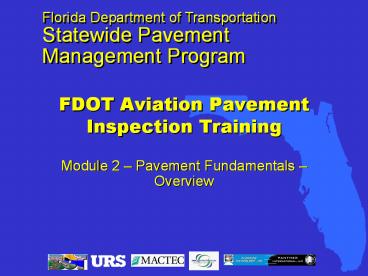FDOT Aviation Pavement Inspection Training - PowerPoint PPT Presentation
1 / 35
Title:
FDOT Aviation Pavement Inspection Training
Description:
Florida Department of Transportation Statewide Pavement Management Program FDOT Aviation Pavement Inspection Training Module 2 Pavement Fundamentals Overview – PowerPoint PPT presentation
Number of Views:115
Avg rating:3.0/5.0
Title: FDOT Aviation Pavement Inspection Training
1
FDOT Aviation Pavement Inspection Training
Florida Department of Transportation Statewide
Pavement Management Program
- Module 2 Pavement Fundamentals Overview
2
Purpose (of Pavements)
- To carry traffic
- Safely
- Smoothly
- Efficiently
3
Pavement Types
- Rigid
- Flexible
- Composite
4
Pavement Types Concrete Surfaced
- Rigid
- Portland cement concrete
- Stabilized or unbound subbase
- Stabilized or natural subgrade
5
Pavement Types Asphalt Surfaced
- Flexible
- Asphalt concrete
- Base (stabilized, unbound)
- Subbase (stabilized,unbound)
- Subgrade (stabilized,natural)
- Composite
- Asphalt overlay
- Rigid system
6
Pavement Materials
- Rigid materials (Portland cement and
aggregates) - Very strong, durable
- Expensive to repair
7
Pavement Structural Behavior
- Rigid
8
Pavement Materials
- Flexible materials (asphalt cement and
aggregates) - Strength affected by temperature
- Relatively easy to repair
9
Pavement Structural Behavior
- Flexible
10
What is Performance/Failure?
- General Categories of Distress
- cracking, distortion, disintegration, loss of
skid resistance - Causes
- Environment
- Swell, blowups (Non-Load, including drainage and
environmental effects) - Load (too much traffic or weak structure (or
both)) - Alligator, corner breaks, joint spalls
- Construction/materials related
- Bleeding, crazing/map cracking
11
Why and How Pavements Fail
Weathering Surface Deterioration
Potholes Heaving
Drainage, Subgrade and Base Failure
12
Why and How Pavements Fail
Load Associated Failures Cracking, Alligatoring,
Rutting
13
Pavement Preservation Concepts
- Right treatment, Right pavement, Right time
- Includes maintenance, rehabilitation and
reconstruction - Built upon a Pavement Management System
14
Pavement Management.
100
90
80
70
60
Pavement Condition
50
40
30
20
10
0
15
Pavement Management ? What Why?
- Decision support tool
- Identifies sections needing treatment
- Allows cost-effective prioritization and
allocation of resources
16
Pavement Management ? Why?
- Planning
- performance prediction
- prioritization
- budgeting
- Maintenance
- identify repair needs
- track effectiveness of repairs
17
Elements of a Pavement Management System (PMS)
- Database
- inventory,
- condition,
- traffic,
- maintenance and rehab (MR)
- history, cost
- Analysis Reporting tools
18
Factors Indicative of Pavement Condition
- Visible surface distress, smoothness, friction
- Non-Visible load response, material strength,
environmental effects on materials load-related
damage
19
Measures of Pavement Condition
- Visual condition survey drainage and shoulder
survey - Ride quality (smoothness/roughness) measurement
- Safety (skid/friction measurement)
- Structural capacity surface deflection
measurement
FDOT PMS uses visual condition survey
20
PCI for Airports
- ASTM Standard D-5340-04
- 16 years of refinement before selection
- USACE 70s
- FAA
- Accepted as an ASTM Standard Practice
21
Components of the Standard
- Distress definitions
- Deduct curves
- PCI Calculation Procedure
22
PCI Procedure
- Inspect sample units
- Determine deduct values
- Determine allowable number of deducts (m)
- Compute the total deduct value (TDV)
- Perform the correction for multiple distresses
(if necessary) - Compute the PCI for each sample unit (S.U.)
- Calculate area-weighted average the S.U. PCIs
for the section - Send to FDOT for entry and PCI calculation
23
FDOT Inspections
- Locate SU for inspection use Network Definition
drawing - Wheel and paint to identify
- Locate centroid of SU Obtain and record GPS
coordinates - Perform distress data collection using PDA
(handheld) or PenTablet (paper forms always for
backup) - No need for curves or calculations all
computerized
24
Network Definition Drawing
25
(No Transcript)
26
Network Definition Drawing - Detail
27
Locate A Specific Sample Unit
- Where is 6105 106 ?
- Measure 300 feet from RW end to SU 106
- Mark corners of begin end of SU
- Measure forward 50 ft to end of SU
- Mark Corners of end of SU
106
28
What is a Centroid?
29
What is a Centroid?
30
Paper Forms
31
Paper Forms
32
Field Maps and GIS
- Use network definition drawings to locate sample
units - Record undocumented new construction
- Modifications to the proposed sampling plan and
additional sample units. - If pavement abandoned do not survey
- If new pavement record dimensions, surface type
and survey during this inspection - Use of Geographic Information System and the
global positioning system (GPS) to assist in
locating sample units (always have wheel for
backup)
33
Safety Considerations During Pavement Inspections
- Safety requirements for personnel conducting
airside pavement inspections - Notify airfield prior to arrival
- Check in on arrival
- Ask about local communication and operations
issues UNICOM radio - Never one-person survey(make sure someone is
aware you are on the field and they are watching
you)
34
Data Quality Accuracy and Consistency
- How to maintain quality, accuracy and consistency
of field inspections? - Training
- Planning
- Always have the field manual
- Resurvey and compare every day 2-3 SU for each
person/crew
35
Review / Questions?































